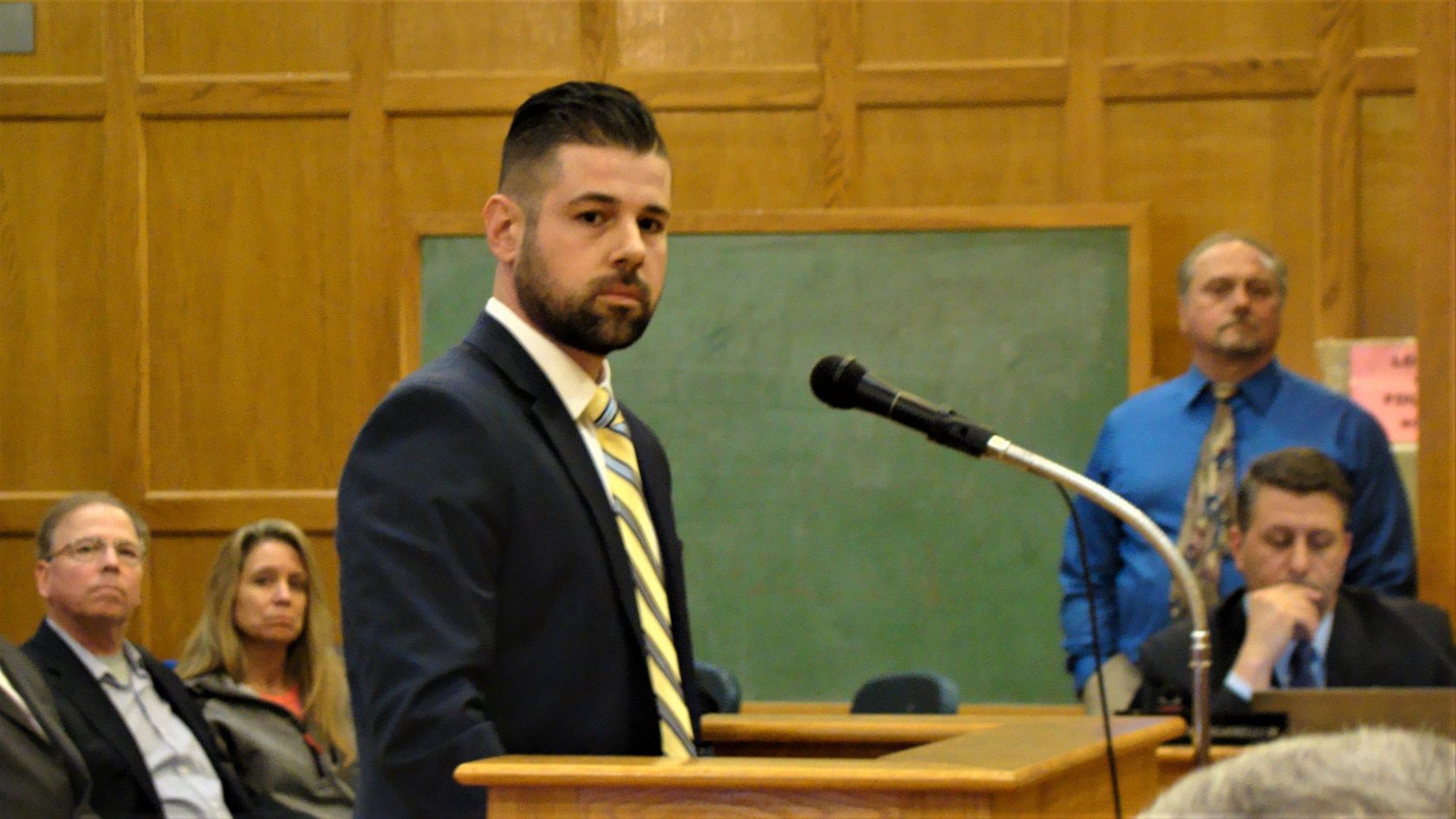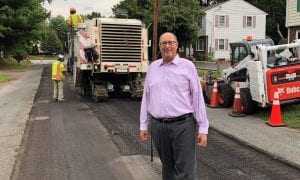
Conrad Leger of the BETA group presents the Pavement Management Program at City Council. (Photo by Amy Porter)
WESTFIELD – David Billips, Director of the Department of Public Works and City Engineer Mark Cressotti introduced a new pavement management program to the City Council last Thursday. The program created by the BETA Group, a full-service engineering firm with offices in Chicopee and around New England, did a comprehensive assessment of Westfield roadways and what it would take to fix and maintain them.
Before starting, Billips thanked the Mayor and the City Council for their support. He said this year was off to a difficult start, because pothole season doesn’t typically begin until late March, but started early when the asphalt plants aren’t open, forcing the city to use cold patch.
Billips said the city is getting some material now, and is concentrating on Western Ave., which he admitted is “hard to swallow” because of the upcoming work that the state is planning to begin this year. But, Billips said, “It’s crumbling now.”
Billips also pointed to the roadwork repair the department was able to do in the past year, including North Road, Shaker Road and Joseph Avenue, due to other funding that became available. Last year, the department spent $5 million on roadwork. He also said the construction portion of the DPW budget has to go to patching potholes, and they have already spent $100,000 this year patching potholes. He said the department needs to get to the point where patching potholes is a minor piece of the budget, so employees may be freed up to do other work.
Cressotti added that Chapter 90 for the city is roughly $1.2 annually, and the DPW construction budget, $400,000 annually. He then introduced BETA Associate Conrad Leger to share the Pavement Management Plan, which he later said was the first comprehensive assessment the city has done in 20 years.
Leger said BETA works with 120 communities in New England on this type of plan, based on roadway inventory and GIS mapping. He said it’s important in order to maximize roadway management by performing the right repairs at the right time.
Leger’s team spent six weeks driving over 200 miles to rate the roadways in Westfield, based on surface conditions. The assessment included all 251 miles of roadway, in order to make sure that city mileage lined up with Ch. 90 accept road miles. However, not all of those roads are the city’s responsibility. They include 188 miles of city accepted roads, 32 miles of unaccepted roads, 4.8 miles of private roads, and 26 miles of state roads.
Leger said that all of the information from the road assessment was loaded into a non-proprietary mapping program they installed at no cost to the city.
Leger said the teams looked at surface distresses, and gave roadways a Road Surface Rating (RSR) of 0 to 100 on each segment. For example, roadways rated 92 to 100 would be considered in good condition for deferred maintenance. An 81 to 91 RSR would be assessed for routine maintenance, such as crack sealing and fog sealing; and 70 to 80 RSR for preventative maintenance, such as micro surfacing.
A 50 to 70 RSR would call for major rehabilitation with mill and overlay; 20 to 50 RSR, reclamation, and 0 to 20, reconstruction. “Below 50, you’re looking at substantial repair for roadway – the cost increases as the rating goes down,” Leger said. They also looked at line striping, sidewalks and curbing, and assigned repair categories and cost of repair to the roadways based on the RSR.
Leger said the results of the survey for the 184.37 miles of Ch. 90 accepted roadways in the city show an overall rating of 68.3. He said the averages for the cities and towns they work with is in the low to mid 70’s, and Westfield is a little below average.
Leger said the overall rating allows the city to set a benchmark as they move forward in the pavement management plan, and judge their progress by the average rate over time.
Another slide in the presentation showed the existing conditions of the roadways by type of work required and cost. He said there are (approx.) 40.2 miles of roads requiring major rehabilitation; 58 miles requiring minor rehabilitation, 40 miles requiring preventive maintenance, 32 miles requiring routine maintenance, and 14 miles requiring no maintenance.
Leger said if the city were to do all of the work this year, the total cost of the backlog in repairs would be $75 million, curb to curb; not including drainage, sidewalks and ramps.
The next step of the project is to develop a 5-year Capital Improvement Plan with targets and budget requirements. The program has a built-in prioritization report, based on traveled miles, repairs necessary, cost of repairs, and deterioration rates. The cost benefit value report will suggest repairs, and project the cost of the repair and the life extension to the roadway. It will also look at ADA requirements, and utility coordination.
Moving forward, Leger said the breakeven point to stay level, or slightly less, is $2.8 million per year. He said to start gaining ground, the city needs to spend $4 million per year on the roads; and to gain more ground, $5 million per year.
Leger said city staff has the ability to update repairs to roadways into the program, and recalibrate the numbers. They can also add new roadways or accepted roadways into the database. He said the industry standard is to have the roads assessed every three to five years.
Leger then took questions from the councilors before the report was referred to the Finance committee.
At-large Councilor Matt Emmershy asked if the costs were based on contracting out all of the road work.
Leger said that out of all the cities and towns they work with, most don’t have the manpower to pave their own roads, acknowledging that most of the numbers in the report are for contracted out services.
Emmershy asked if the DPW were given funds to buy equipment, such as for crack seal equipment, whether doing it inhouse would stretch some dollars.
“We could do a lot more than routine maintenance, and that would drive the cost down,” said Billips.
Leger said typically it would be based on how much staff is available, how much purchasing the equipment versus contracting out would cost, based on a cost benefit analysis.
At-large Councilor Dave Flaherty said the city was about to spend a lot of money on Western Ave. He said with a life of 15-20 years for the road work, if the city put in money after year eight, could they extend it further, and whether there was a “rule of thumb” for that.
“Every roadway is different. There are a lot of different factors. No real rule of thumb. It’s really based on condition, and that’s why the overall inventories and assessments are so important,” Leger said.
Several councilors asked if they could have a list of the ratings for all the roads in the city, which Cressotti said could be made available.
At-large Councilor Nicholas J. Morganelli, Jr. calculated that with a backlog of $75 million, if the city spent $5 million per year for five years, then repeated it for two more cycles, after fifteen years, the roads they started with are old. “We’ll have to spend $5 million for the foreseeable future,” he said.
Leger agreed that $5 million a year for the foreseeable future would be right because of the RSR starting point of 68. “It would take a while to get at a state of good repair and level out at a much lower rate than $3 million a year, in order to maintain at whatever level (you decide on),” he said.







